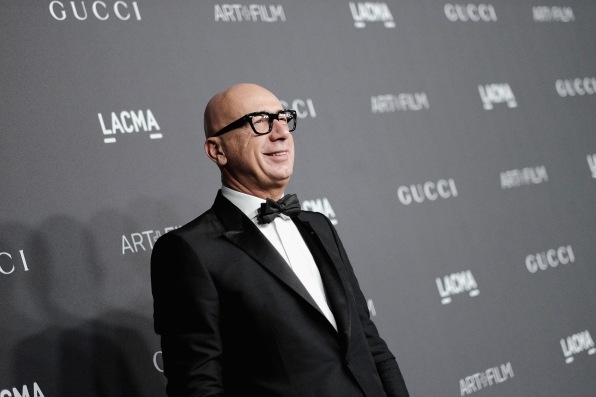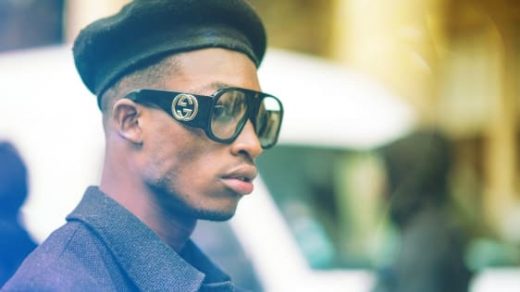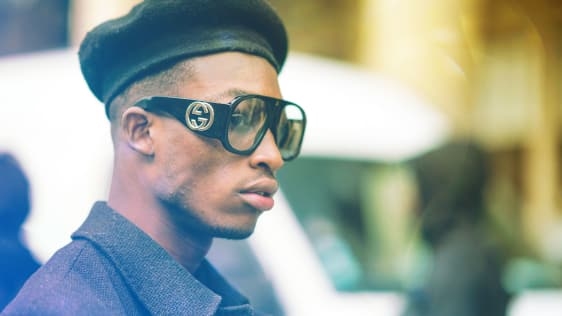Meet The Man Who Made Millennials Fall In Love With Gucci
Gucci, you may have noticed, is blowing up.
Walking down the streets of New York or Milan, twentysomethings are wearing $490 swimsuits splashed with enormous Gucci logos, $1,350 hoodies featuring goofy cartoon images of the creative director’s dogs Orso and Bosco, and $650 fanny packs featuring the brand’s signature diamond print. Fashionable young women are now carrying updated versions of $5,000 classic Gucci bags, this time blinged out with sequins in the shape of lightning bolts and hashtag-worthy words like “Guccify.” (In case you’re wondering, this totally made-up term means to infuse something with Gucci-ness.)
Not long ago, these items would have been considered tacky. Gucci had a brief moment of streetwear popularity back in the ’90s, when rap stars and gangsters clothed themselves head to toe in products plastered with Gucci logos–some of it authentic, some bootleg. Back then, Gucci’s leadership didn’t want the brand associated with these consumers, so the brand aggressively sued manufacturers of counterfeit products.
Today, Gucci has shed its once-imperious identity. The brand now partners with Harlem tailor Dapper Dan, the man who first made Gucci popular with the hip-hop crowd, and rappers are now all over Gucci again. In 2016, the name Gucci was splashed all over the lyrics of 2 Chainz, Pusha T, and Tyga. On Instagram, meanwhile, Gucci invented its own meme, poking fun at itself as if to say, “We know fashion can be silly sometimes, we get it.” In conjunction with the launch of a new watch collection, the company created the hashtag #TFWGucci (thanks for watching), pairing funny images featuring a timepiece with humorous captions. A hand wearing a watch cradles a statue of a bust and is paired with the phrase, “When you wake up late for work and realize you are actually a clay head.” Another features a swimmer wearing a watch saying, “When you have Aquagym at 3pm but you need to accessorize your existential angst eternally.”
Gucci Gets Its Cool Back
It is possible to identify the exact moment Gucci got its cool back. In January 2015, Gucci appointed a new CEO, Marco Bizzarri, who had previously led Stella McCartney and Bottega Veneta. Bizzarri immediately brought on a new creative director, Alessandro Michele, who earned his design chops apprenticing under Karl Lagerfeld and Silvia Venturini Fendi, and is known for his eccentric maximalist taste. In three short years, the pair have transformed Gucci into an exciting, modern brand that has won over the under-35 set–an achievement that recently earned the company a place on Fast Company’s list of the World’s 50 Most Innovative Companies in 2018.
Half of the brand’s sales now come from millennials, who are propelling revenues upwards every season, buying up accessories rather than more expensive ready-to-wear pieces. (A 25-year-old can save up for a $300 belt, but a $13,000 bomber jacket is a little less accessible.) In the third quarter of 2017, sales spiked by 49%, hitting $1.82 billion. Gucci’s parent company, Kering, has benefited from the brand’s success. Since Bizzarri joined the company, Kering’s overall sales and stock price have soared.

Bizzarri approached the 96-year-old fashion house with a critical eye. When he joined the company, the brand’s enormous double G logo seemed like a status symbol of a bygone era; Gucci bags and belts languished in dark corners of people’s closets. “The company was really losing speed and was a little bit dusty,” Bizzarri says. “There was too much emphasis on heritage. I wanted to move the company to be more inclusive, more joyful, full of more energy.”
This was easier said than done. Gucci is a big company with over 13,000 employees–and nearly 60,000 who work indirectly for the brand as retail workers and consultants. “Changing the aesthetics was the easy part, since Alessandro had a clear idea of what he wanted,” Bizzarri says. “It is changing the culture among the employees that was hard.”
“We Are In Fashion, We Are Not Saving Lives”
I sat down with Bizzarri to discuss this transformation. He explained that paradoxically, the secret to his success was not putting too much pressure on himself or his staff. He recalls his very first leadership meeting as CEO, where he told his team: “We need to remember that we are in fashion, we are not saving lives.” In other words: Doctors and disaster-relief specialists should take themselves seriously, Gucci employees should just chill and enjoy the creative process. (That said, Gucci recently joined the gun-control movement by committing a half a million dollars to the March For Our Lives on March 24, started by the students of Parkland, Florida.)
To people outside the industry, taking your brand less seriously in order to attract millennials seems like an obvious approach, but anyone who works in fashion knows that people believe that the stakes of their job are very high. At luxury fashion houses, especially, there is a great deal of pressure to protect the brand’s image and heritage. Bizzarri’s message to his employees was to relax. “This creates a shift in people’s minds,” he explains. “If you don’t take the work too seriously, you can experiment with things that people are not expecting. On the other hand, by taking it too seriously, you tend to replicate things you have already done, trying to be safe rather than innovative.”
One of the biggest risks that Bizzarri took was hiring Michele as creative director, given his outlandish style and his appreciation of streetwear. Bizzarri says that he had met Michele by chance and intuitively felt that he understood what Bizzarri himself was trying to achieve. “I wanted to have a company culture to be one where emotion and creativity were at the front and business followed,” Bizzarri says. “A place where creativity is foster by joy, by happiness. This is a perspective that I shared with Alessandro.”
Protect The Creatives
After tapping Michele, Bizzarri empowered him to execute his vision. While Bizzarri is constantly getting feedback from millennial employees in the organization and taking in consumer data on social media, Bizzarri says that he doesn’t allow all this input to change Michele’s creative process. “We listen to the customer on a daily basis, but you cannot focus too much on what they want when you want to change your business,” he says. “The changes we made were so disruptive and different from what they were expecting, and consumers tend to prefer what they are used to. For this reason, when you begin to do something new, you need to protect the creatives in your company (from too much interference).”
And Michele has brought a fresh new look to Gucci. It’s an aesthetic that is entirely unique, much like the man himself. With long dark hair and a beard, Michele looks a bit like Jesus as painted by renaissance artists. At black tie events, you might find him in suits covered in larger floral prints or embroidered with chinoiserie lions.
Michele grew up in Rome, surrounded by great works of art. He has a skill for combining aesthetics from different periods of history into a coherent look. A recent fashion week show featured a model in a delicate translucent teal gown reminiscent of a Grecian robe; it was emblazoned with letters and a puma mascot drawn from an American high school athlete’s varsity jacket. Another model walked down the runway in a classic 1960s mini dress paired with rococo pearls right out of the French royal courts. Everything Michele creates is drenched in color and full of bold prints.
Bizzarri was right to trust Michele’s instincts. His first collections were widely praised by both fashion critics and fans of the brand. Within months, Michele had won an award from the Council of Fashion Designers of America, one of the highest honors in the industry.
This popularity has translated into profits. Gucci’s accessories line, in particular, have been a hit with millennial consumers. The Dionysus bag, for instance, which costs between $3,000 and $4,000 for the medium size, has been a best seller. The bag has an iconic, structured rectangular shape with a G clasp, but in Michele’s hands, it is now plastered it with sequined hearts, lightning bolts, and odd images of mouths. He also added his touch to the classic $1,000 Princetown loafer, which is now bedazzled with embroidered lions and flowers, or lined with fur. Belts feature buckles in the shape of bees or tiger heads, all encrusted with Swarovski crystals (running for $700).
Inventing An Inclusive Luxury Brand
Bizzarri also set out to make Gucci more approachable and friendly. To him, this had nothing to do with the price point of the products, which is high and is not in the budgets of most twentysomethings making $40,000 at their first job. But as a steward of the brand, he doesn’t see his role as necessarily to sell as many products as possible, but to cultivate positive associations with the house of Gucci. This, he believes, has everything to do with how the company speaks to customers at every touchpoint, from social media to the way that shop assistants engage with people that stroll into the store.
This was a complicated thing to achieve. Many luxury brands thrive on their exclusive status and drive demand by being aspirational and a little out of reach. Bizzarri doesn’t think this is what the consumer wants. “We needed to start seeing luxury as creating beautiful, unique products,” Bizzarri says. “It doesn’t mean that when you enter a shop, the shop assistant looks you up and down to see whether you are able to afford our bags.”
Bizzarri says one of his biggest challenges has been getting everybody at the company in line with his vision. He says he needs to reiterate this message constantly. “If people enter our shop, they enter our house and we need to be hosts to them,” Bizzarri says. “Changing people’s mentalities and behavior, that is the most difficult thing to do. The approach should be welcoming and smiling in a genuine way that is not forced, because this is the way to be inclusive in the end.”
To Preserve Your Brand, Win Over Millennials
While some industry watchers have wondered how long Michele’s idiosyncratic aesthetic can sustain the brand—and whether his designs are simply too trendy for the long-haul—Bizzarri says the company’s new energy is based on more than just its visual identity.
He is focused on building a brand that appeals to millennials. This means bringing young people into the conversation by speaking to them on social media; encouraging customers to style products in their own ways, from hip-hop street style to formal red carpet looks; and using models that are ethnically diverse and gender fluid. (One mark against the brand on this front is that it still does not feature plus-size models in its imagery.)
Many luxury brands have not focused heavily on the millennial set since their disposable income is lower than older generations. But Bizzarri believes that by cultivating a brand that millennials can appreciate, he is setting the company up for long-term success. “Our approach, both in terms of product and visual campaigns, is to do something that is unique,” he says. “The point is that if you are able to spontaneously and genuinely talk to millennials in a way that they can see really comes from the heart, you are talking their language.”
These social media gambits are timely and speak directly to millennials, but Bizzarri wants to make sure that the driving force behind everything that Gucci does is about being authentic, creative, and inclusive, because this is what will allow the brand to stand the test of time.
“This genuine passion is something that can keep us ahead of the competition,” Bizzarri says. “I’ve read many things about millennials these days saying they are not loyal and switch from one brand to the text. This may be true, but it doesn’t apply to us.”
(78)



